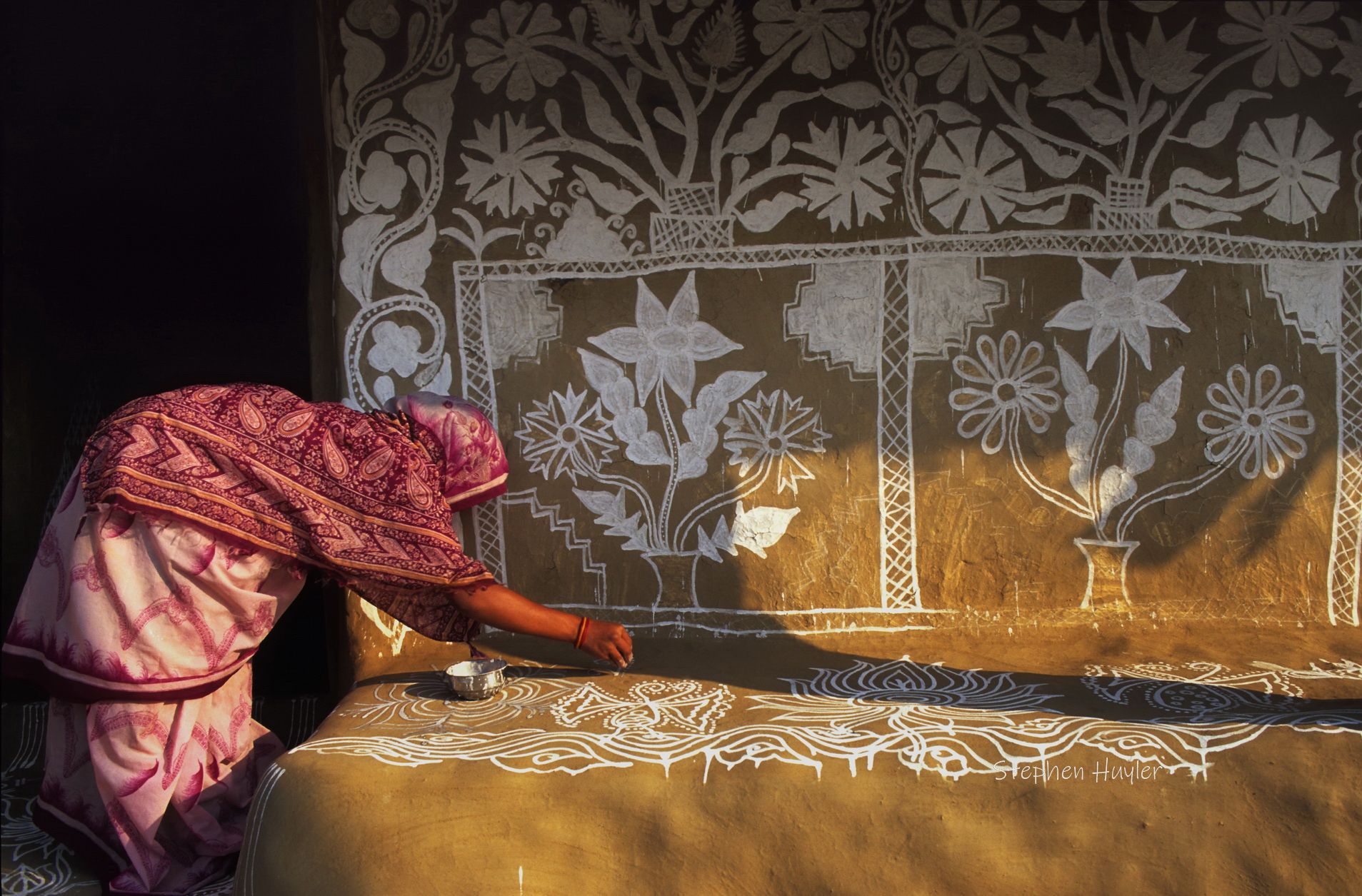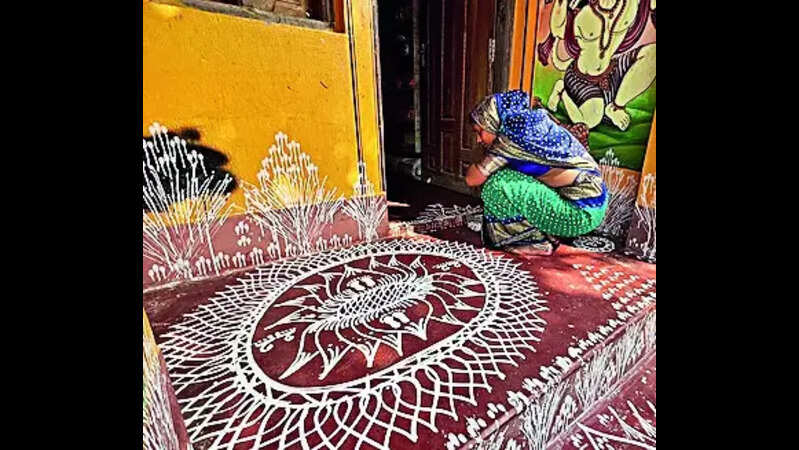In a world of AI-generated Ghibli art and NFTs, there is a quiet art that still begins with mud walls and rice paste. It is called Jhoti Chita– Odisha’s own ephemeral, ritualistic folk art, drawn by grandmothers not for galleries but for gods and goddesses. This isn’t just geometric doodling, it is storytelling– all painted by hands dipped in a paste of ground rice and water, born from the rhythmic flick of her fingers.
A Hand-drawn Homage

In Odia homes– especially in rural districts of Puri, Sambalpur and Ganjam– Jhoti is drawn freehand, without any stencils. Women usually use their fingertips or twigs dipped in rice paste (pithou) and drawing geometric patterns on floors and walls smeared with cow dung or red earth.
The result is white, symmetrical motifs that emerge all over the wet earth like constellations– temporary, but sacred.
From Marriage to Monsoon: Rituals that shape this Art
Jhoti isn’t done all year round– it appears only on special, auspicious occasions. Some of the most vibrant Jhoti rituals include:
- Manabasa Gurubara (Marghashira month) → Paying respect to Goddess Lakshmi, women draw Alati Jhoti– a combination of lotus, feet and conch motifs– to welcome the goddess of wealth into their homes.
- Marriage ceremonies → The walls are filled with elaborate Jhoti patterns, with motifs like mayura (peacock), kalasa (holy pots) and floral patterns to sanctify the space.
- Raja Festival → The Raja parba/festival is a celebration of the earth goddess Bhudevi’s return to fertility as it marks the shift from hot scorching summer to the arrival of monsoon that restores fertility to the earth. During this period, women are given 3 days of rest and girls are dressed up in new clothes and celebrated. Floral and circular motifs of Jhoti chita are drawn all around the kitchen and temples, celebrating menstruation as the root of all life and joy.

The Motifs
1. Lakshmi’s feet: One of the most iconic symbols in Jhoti Chita is a small pair of inverse footprints walking into the home, symbolising Goddess Lakshmi’s entry into the household, filling it up with prosperity. Often surrounded by rice sheaves and lotus motifs, the feet are small and stylised, aligned towards the door. You don’t just open your door and wait for Lakshmi to arrive– you decorate her path to show her the way.

2. The Kalasa: The kalasa or sacred pot is a powerful Jhoti motif used in weddings and pujas, drawn with a round base and a flared top. It is symbolic of the womb, abundance and creation. It is also a metaphor for a space that man makes to hold things coming his way. On top of the kalasa, mango leaves and a coconut are drawn to symbolise wholeness. In Odia tradition, placing a real kalasa at the entrance and painting one besides it doubles the wholeness– it is where ritual and representation merge into one.
3. The Mayura: The Jhoti mayura (peacock) is more than just a bird– it is an emblem of majestic beauty and a rain-caller. Usually drawn during weddings and Raja Parba, the peacock motif is elaborate, with swirling tail feathers and round dotted eyes. Much like the stitched peacocks in Pipili applique and the feathered forms in Pattachitra, Jhoti’s peacocks spread out in the middle of the stage. Some jhotis even show a pair of peacocks facing each other, symbolising love and harmony in the bird kingdom.

4. The Circle and the Star: At the heart of all Jhoti designs lies the circle– a symbol of the cycle of seasons. Tara (stars) are drawn within and around these circles, sometimes in octagonal or pentagonal symmetry. In many tribal-influenced versions, these resemble mandalas– linking Jhoti to pan-Indic philosophies of the cosmos. The combination of circles (representing the universe) and stars (representing points of energy) is believed to ward off evil and channel positive energies during important events like Gruhaprabesa (house warming ceremony) and Nua Khai (new harvest).
A Sisterhood of Symbols
Like any other art form, Jhoti does not exist in isolation. It’s sister art forms from other states echo similar visual languages and ritualistic intent:
1. Alpana in Bengal uses rice paste on floors for Durga Puja with lotus and feet motifs.
2. Rangoli in Maharashtra and Karnataka uses dry colourful powder to make vibrant floor art during Diwali.
3. Mandana Art in Rajasthan and Madhya Pradesh uses a mix of cowdung, chalk and red mud on walls and floors to draw kalasa and peacock motifs.
Each of these art forms shares the common theme of geometry and the common medium of the domestic space.
Conclusion

Today, Jhoti Chita lives on– in courtyards, festivals, and fading memory. In villages, women still draw it with rice paste and reverence; in cities, it appears in white chalk at Diwali and rangoli contests. Stencil kits have entered the picture, bringing speed, but also dilution. But its core remains intact: storytelling through symmetry. Modern-day initiatives like Sanskar Bharathi’s national-level rangoli competitions in Bhubaneshwar have brought fresh eyes to this tradition, turning pavements into galleries and reviving pride in local identity. Museums like Kala Bhoomi, Odisha’s living craft museum, have also begun offering workshops where participants can learn to create Jhoti panels using both rice paste and acrylics on tote bags, fabrics and terracotta. Perhaps most vibrant is the birth of Lalit Kala academy’s art gallery where more than 100 women of all age groups from Raghurajpur’s crafts village made Jhoti Chita murals in 2023. From the walls of cowsheds to Instagram feeds, Jhoti Chita is quietly carving its space in the contemporary canvas, reclaiming visibility for what was once confined to private, gendered spaces. With every drawn curve and dotted arc, Jhoti reminds us quietly: Heritage isn’t just preserved, it is practiced.
References
Dash, B., & Prusty, S. K. (2018). Exploring invisible speech in ritual art: A combinational study in cultural-linguistic landscape. Indian Journal of Applied Linguistics, 44(1–2), 187–205.
Dash, B., Prusty, S. K., & Nayak, S. (2017). Jhoti Chita Muruja: The therapeutic art forms as a cultural practice in the kaleidoscope of linguistic landscape of Odisha. Retrieved from https://www.researchgate.net/publication/316280833
Hans, A., & Das, A. (2012). Chitta: The traditional art of Odisha. Odisha Review, May, 36–38. Retrieved from https://magazines.odisha.gov.in/Orissareview/2012/May/engpdf/36-38.pdf
MAP Academy. (n.d.). Jhoti. Retrieved from https://mapacademy.io/article/jhoti/
Chowdhury, S. (2023). Jhoti Chita – Floor and wall paintings of Odisha. Caleidoscope. Retrieved from https://www.caleidoscope.in/art-culture/jhoti-chita




